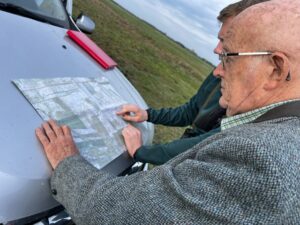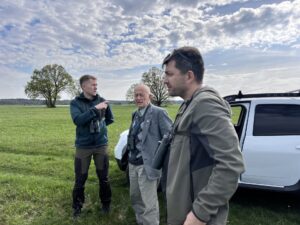This is the first of two blog posts on Curlew Action's visit to Poland. Read Mike Smart's blog post.
A warm wind blew across a very large field in Eastern Poland, it was mid-April and uncharacteristically mild. In the distance a farmer ploughed one small area, his engine a grating background to the music of Skylarks that were dotted through the air. The grass was growing fast. In June it will be cut for silage, which is worrying, as three pairs of Eurasian Curlews nest here, three out of a paltry 200 pairs left throughout Poland. It is astonishing and devastating to know that on our watch Curlew numbers have dropped to such a critically low level.
Field ecologist Dominik Krupiński took out a tape lure and played a bubbling call, characteristic of the mating season. He knew it would arouse the curiosity, and the ire, of any other birds in the area, and he was right. Within minutes a male appeared, flying low across the field, calling urgently as it landed near the car. Then another, higher and more distant bubbling, which got louder as the bird flew closer; it too touched down not far away. Both males looked around and seemed up for the fight. Eventually, with no adversary to fend off, they moved further away, bubbling as they went. Relief for the Polish Curlew team, though, the birds are back for another year, and they know the third, younger male is on its way from Spain and should arrive any day.

A short distance away the wide, sparkling river Bug looked beautiful and peaceful. Water and birdsong are a magical combination. This fertile, flat river valley is divided into long, thin strips and cultivated by numerous farmers, making it very difficult to know who owns what - a big headache for conservationists. The water rippled to the backdrop of singing Skylarks, Curlews, and the strange, ancestral call of Cranes.
One of the male Curlews had a yellow flag, which Dominik recognised as a regular. Each year it winters in Spain and breeds in this vast field. Last year the pair tried twice but lost both clutches to predation, most likely crows – there were a lot of crows. He reckons a female is already settling on eggs as the yellow-flagged male let out a low, slow, melancholic whistle, a tell-tale contact call to its hidden mate.
The two males joined forces once again as a Red Kite flew overhead, mobbing and harassing until it gave up and retreated over distant trees. It was a reminder that when bird numbers were healthy, they could easily see off danger, but with only two or three pairs, and very few birds of other species like Lapwings to help, it is a constant, energy-draining, daily battle.

Dominik explained this area is a Natura 2000 site, which affords it some protection, but how much isn’t clear, it seems to depend as much on goodwill as legislation. With such complex ownership, by far the best way to protect the birds is to buy the land and manage it themselves. Many farmers are willing to do this as farming is proving less and less viable, with few young people taking up the challenge. This grand plan looks more likely with the success of the Curlew team’s bid for EU LIFE programme money, a few more tens of hectares could be under their control very soon.
As we drove away, four Hooded Crows walked across the grass and in the reeds fringing the river, three Black Storks hunted for fish.

The next river valley, the Pulwy Marshes, holds 11 pairs, with an extra couple of males that don’t have a mate. Headstarted birds are coming back here to breed, keeping the population going. Without headstarting, the Polish Curlew population would be in freefall, as it is, they are hanging on while the team battle to do more extensive habitat management and targeted predator control. I feel there is more the UK can learn about the Polish approach to headstarting, which we will continue to explore.
The drive between the Curlew sites was through flat agricultural land, and it is striking how few, if any, cattle live out of doors. In line with much of Europe, the majority of cows are kept in sheds all year and fed on grass cut multiple times in the spring and summer months. So many cows, so much cut grass, so few ground-nesting birds. It is a folly to blame farmers, anyone who drinks milk and eats meat is part of the problem and the solution – including me. We must find a way for farmers to make a living and for wildlife to thrive amongst our high demands, and for cattle to have a humane, good life.
By late afternoon the birdsong intensified, and a calmness settled over the fields. We had a small picnic overlooking the most important Curlew areas, listening to them bubbling and whistling. A female by the road was remarkably candid, she was stunningly beautiful and elegant. Others were just dark shapes in the distance, they reminded me of mini metal-detectorists, with their characteristic slow walk, heads down, investigating the earth. The sight and sound of them was so moving.
There is such a strong bond between Polish and British Curlews. We know from ringing data that the UK is an important wintering site, and Poland is doing its best to keep hold of them in the breeding season. In the West Country, our relationship with Poland began in 2018, when Dominik confirmed a bird that wintered along the River Usk was breeding in one of his study areas. Since then, we know of many more regular commuters. The relationship with Poland was strengthened by Curlew Action’s recent Curlew Fieldworker European Workshop, held in Norfolk in February 2024.
I am more convinced than ever that regular exchanges between Europe and the UK will help us all to tackle the enormous challenges posed by our intensive, farmed landscapes. We are all facing the same issues, we all have different solutions, and we are all staring into the extinction abyss. Curlews will only survive if we actively and openly exchange expertise and ideas and come up with landscape scale solutions, we cannot do this solely field by field and in isolation.

The Polish team do a cut-down, budget version of headstarting, which Mike will explain in our next blog post. It is the longest running programme in Europe, but suffice to say it is effective and pragmatic, tailored to no money and an urgent situation. They usually only take two eggs from a clutch, not four as here. The explanation is complex, and I quote from Prezmek:
Where we were with you Pulwy Marsh and the Bug River Valley, meadow mowing mainly starts in late May and early June.The first complete curlew clutches are average between 20-25 April. These broods are likely to hatch before mowing. Besides, we can cooperate with farmers and leave the nest surroundings unmowed. By leaving 2 eggs in such a nest, we give the curlews a chance for "a small natural breeding success". In addition to headstarting, we want the curlews to have the chance to reproduce in a natural way.
Unfortunately, most such first nests are predated. Some pairs may then have replacement clutches. Second clutches are well hidden (vegetation is already high) and finding them is difficult and very time-consuming. We are not doing well looking for them. Maybe this will be improved in the future, for example by using thermo drones. As Dominik wrote, replacement clutches are more likely to be mown down than first nests. But some repeated nests have a chance to survive if they are in extensive meadows, e.g. in AES schemes that are mown later.
We currently have limited capacity (financial, staff) and try not to exceed 25-30 eggs in the incubator. We try to find as many first nests as possible. By taking mostly two eggs from the nest we are able to collect this number of eggs. We still do not have funding guaranteed this year, but we decided to take a risk and have already collected 24 eggs (four eggs from one nest and two eggs each from ten nests). We have eggs from 11 breeding pairs in the incubator. If we were to collect four eggs each from the first nests it would be six pairs, with a maximum of seven, because as I wrote we do not have the capacity for more than 30 eggs. So taking two eggs also results in higher genetic diversity in the released birds. At least that is what we think.
Our 'two eggs' approach is adapted to our current capabilities and conditions. We do not claim it is the best way. Maybe in the Life project we will increase the number of eggs collected and take all the eggs from the first nests more often. That's what they do in western Poland, they always take all four eggs to the incubator.
A huge thank you to Michał Korniluk, Przemslav Obloza, Dominik Krupiński and the wildlife NGO Bocian for such an enlightening and welcoming visit to this wonderful and important Curlew country.

